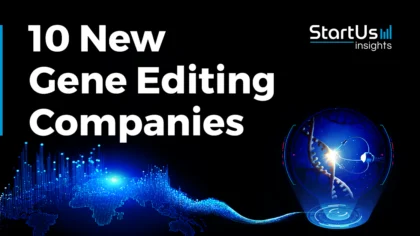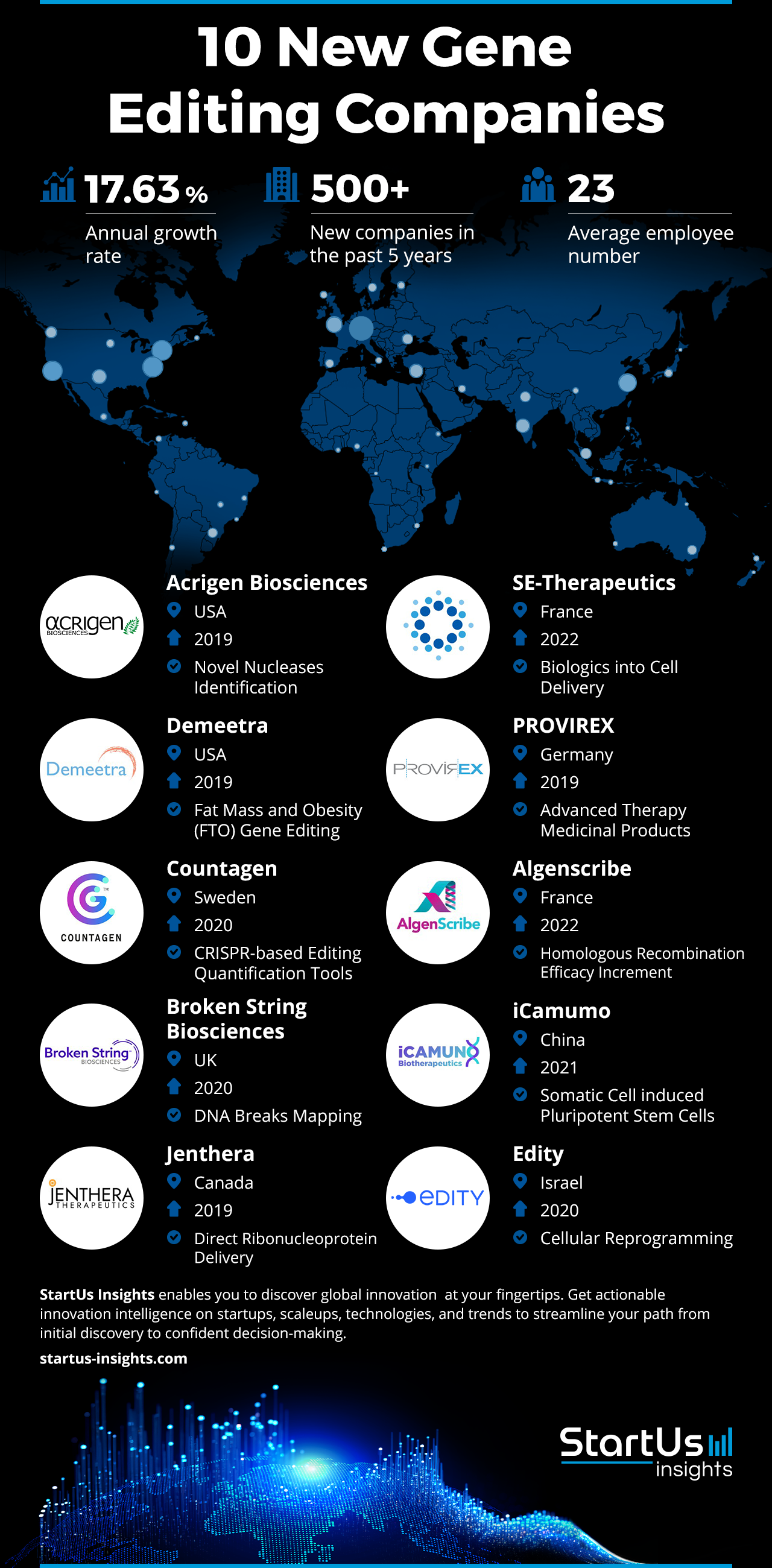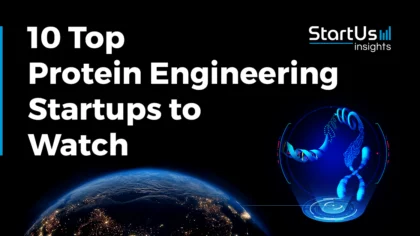Accelerate Productivity in 2025
Reignite Growth Despite the Global Slowdown
This article examines 10 new gene editing companies that leverage methodologies such as clustered regularly interspaced short palindromic repeats (CRISPR), transcription activator-like effector nucleases (TALENs), zinc-finger nucleases (ZFNs), and more. These firms allow for more precise and less disruptive alterations to DNA.
Such companies address hereditary diseases and explore therapeutic applications in cancer treatment and infectious disease management. Additionally, these companies develop technologies in animal husbandry and agriculture by enabling enhancements such as increasing disease resistance, improving productivity or nutritional profiles.
Continue reading to gain up-to-date and data-driven insights on:
Key Takeaways
Drawing insights from the Big Data & AI-powered StartUs Insights Discovery Platform that provides data on over 4.7+ million emerging companies globally, we explore the evolving landscape of the gene editing industry. This sector is marked by key trends and a substantial workforce, shaping its future. This report was last revised 5 days ago. See a missing piece? Your input can help — contact us. Here are some key insights at a glance:
- Current Gene Editing Trends: The latest gene editing trends include clustered regularly interspaced short palindromic repeats (CRISPR), base editing, stem cell editing, DNA sequencing and synthesis, and homing endonucleases.
- Gene Editing Industry Stats: The global gene editing industry encompasses 2K+ organizations with an annual growth of 17.63%. The sector has seen an emergence of 500+ new gene editing companies in the past five years and each of these organizations employ about 23 people. Witnessing 2020 as the average founding year, these 500+ companies receive an average funding of 47.6M.
- 10 New Gene Editing Companies to Watch:
- Acrigen Biosciences – Novel Nucleases Identification
- Demeetra – Fat Mass and Obesity (FTO) Gene Editing
- Countagen – CRISPR-based Editing Quantification Tools
- Broken String Biosciences – DNA Breaks Mapping
- Jenthera – Direct Ribonucleoprotein Delivery
- SE-Therapeutics – Biologics into Cell Delivery
- PROVIREX – Advanced Therapy Medicinal Products (ATMPs)
- Algenscribe – Homologous Recombination Efficacy Increment
- iCamumo – Somatic Cell induced Pluripotent Stem Cells
- Edity – Cellular Reprogramming
Discover 10 out of 500+ Emerging Gene Editing Companies
In this section, we highlight 10 top gene editing companies that develop technologies such as somatic cell-induced pluripotent stem cells, nucleases for precise genetic modification, and more. Their contributions span from therapeutic applications to research.
Note on Signal Strength
One of the unique metrics we feature for each company is Signal Strength, a proprietary data point generated by our Discovery Platform. It gauges the extent to which a company’s influence has permeated the global ecosystem of startups, scaleups, and emerging companies. This proprietary metric serves as a valuable guidepost for understanding a company’s standing in the broader market landscape.
1. Acrigen Biosciences
- Founding Year: 2019
- Employee Range: 2-10
- Location: USA
- Signal Strength: Very Strong
- What they do: Acrigen Biosciences developed αCas and μCas, two families of novel CRISPR-Cas nucleases for human gene editing. Using the proprietary Nuclease Discovery Engine, the company identifies libraries of CRISPR-Cas enzymes for use in human gene editing therapies. These editing systems further undergo optimization for editing genome in in-vivo and ex-vivo applications. To increase the precision of the company’s gene editing systems, it developed Engineered Recombinant Anti-CRISPR (ErAcr) proteins. These small peptides eliminate off-target gene editing by selective inhibition of the CRISPR-Cas nuclease.
2. Demeetra
- Founding Year: 2019
- Employee Range: 11-50
- Location: USA
- Signal Strength: Very Strong
- What they do: Demeetra leverages Cas-CLOVER and piggyBac technologies to provide high precision and flexible gene editing solutions for fat mass and obesity (FTO). Cas-CLOVER, known for clean gene editing, facilitates targeted double-strand breaks with high specificity and minimal off-target mutations. The piggyBac transposase system allows for the stable, footprint-free integration of genetic cargo. These technologies find applications in mammalian cells, yeast, and plants, optimizing gene editing for pharmaceutical bioprocessing, synthetic biotechnology, and agriculture.
3. Countagen
- Founding Year: 2020
- Employee Range: 2-10
- Location: Sweden
- Signal Strength: Very Strong
- What they do: Countagen builds CRISPR-based genome editing quantification tools for enhancing the transition from gene editing to functional analysis. The company’s GeneAbacus kit is a package of reagents, consumables, and software that measures CRISPR editing efficiency. Further, the company utilizes methods such as padlock probes and rolling circle amplification to provide precise editing event counts. It also distinguishes between edited and unedited sequences with single-base accuracy. This way, the company’s solution measures the specificity and efficiency of research, drug development, and personalized medicine.
4. Broken String Biosciences
- Founding Year: 2020
- Employee Range: 11-50
- Location: UK
- Signal Strength: Very Strong
- What they do: Broken String Biosciences develops INDUCE-seq technology to map DNA breaks that understands genetic code disruptions for developing new medicines. This technology labels DNA breaks in cross-linked cell samples to capture their frequency and location. By employing a polymerase chain reaction (PCR)-free workflow for DNA preparation and sequencing, INDUCE-seq specifically targets fragments corresponding to DNA breaks. This ensures a precise digital readout of double-strand breaks. The company’s process thus reveals the interactions between gene editors and the genome. It enhances the characterization of cell and gene therapies and accelerates the development of safe and effective therapeutic applications.
5. Jenthera
- Founding Year: 2019
- Employee Range: 2-10
- Location: Canada
- Signal Strength: Very Strong
- What they do: Jenthera uses a CRISPR platform to overcome cellular delivery challenges. It uses a biologic approach for direct ribonucleoprotein delivery. This eliminates the need for adeno-associated viruses, liposomes, or nanoparticles, offering a safer and more efficient gene editing method. The platform also offers high specificity across diverse targets to enable systemic, targeted in vivo delivery through intravenous methods. It supports different genetic manipulations, like knock-outs and knock-ins, to provide improved therapeutic strategies.
6. SE-Therapeutics
- Founding Year: 2022
- Employee Range: 2-10
- Location: France
- Signal Strength: Medium
- What they do: SE-Therapeutics’ CRISPR/Cas9-based Self-Entering Domain (SED) technology uses a bacterial toxin. SED leverages its high binding affinity to bind to a common cell receptor. This binding initiates entry into cells through receptor-mediated endocytosis. During the cellular trafficking process, SED‘s secondary domain activates to breach the endosomal membrane and release the biological cargo directly into the cytoplasm. The biologic then targets intracells with antibodies and other modalities to deliver biologics into cells and develop cell and gene therapies.
7. PROVIREX
- Founding Year: 2019
- Employee Range: 2-10
- Location: Germany
- Signal Strength: Very Strong
- What they do: PROVIREX develops advanced therapy medicinal products using genome editing to avoid persistent viral infections. The company uses site-specific recombinase-based genome surgery for removing viral genome from host cells. While offering nucleotide precision, the technology also avoids errors typical in other gene editing technologies, and it specifically targets HIV-1 proviruses. Thus, it assists in declining plasma viral load below the detection limits.
8. Algenscribe
- Founding Year: 2022
- Employee Range: 2-10
- Location: France
- Signal Strength: Medium Strong
- What they do: Algenscribe offers a genome editing platform to improve homologous recombination efficiency and nuclease-based editing. Using this technology, DNA is cut at targeted sites, with cells utilizing two repair processes: non-homologous end joining (NHEJ) and homology-directed repair (HDR). NHEJ results in gene inactivation and unintended mutations while HDR is facilitated with amplified donor DNA to enable precise gene repair.
9. iCamumo
- Founding Year: 2021
- Employee Range: 51-100
- Location: China
- Signal Strength: Strong
- What they do: iCamumo creates somatic cell induced pluripotent stem cells, named iCam-iPSCs based on somatic cell reprogramming and human embryonic development. The company’s gene editing platform, iCam, guides iPSC differentiation and improves the accuracy and efficiency of gene editing. It strengthens the specificity, lethality, and safety in tumor-fighting immune cells. Also, the platform uses algorithms and single-cell omics to refine the process of inducing pluripotent stem cells to differentiate. This leads to more effective generation of various cell types, including those used in tumor immunology and regenerative medicine.
10. Edity
- Founding Year: 2020
- Employee Range: 11-50
- Location: Israel
- Signal Strength: Very Strong
- What they do: Edity’s technology uses the immune system and integrates therapeutic proteins into the perforin/granzyme pathway to deliver these proteins into the cytosol of cells. This enhances protein design, expression, and transferability efficacy for disease modulation. The technology also changes the course of disease at the intracellular level via mechanisms such as protein replacement, target modulation, genetic correction, and protein gain of function.
Quick Tip to Find New Gene Editing Companies
Utilizing a SaaS platform like the Discovery Platform for identifying new gene editing companies provides significant benefits compared to traditional scouting methods:
- Streamlined Efficiency: The Discovery Platform offers advanced tools that streamline the scouting process. It replaces hours of your conventional desk research, saving time and resources in identifying gene editing innovations.
- Access to Real-time Insights: Gain a competitive edge with up-to-date information on the latest trends in the gene editing industry. The platform keeps you informed with near real-time updates on emerging gene editing companies and news. So, you make swift and informed decisions.
- Tailored Exploration: Customize your search to focus on specific niches within the gene editing sector, such as pluripotent stem cells, DNA break mapping, or CRISPR-based editing quantification tools. The platform’s diverse filtering options allow you to target your scouting efforts precisely, ensuring that you find the most relevant and groundbreaking gene editing solutions.
Ready to Explore All New Gene Editing Companies?
We’ve explored the dynamic landscape of the gene editing industry, examining the latest trends and spotlighting exceptional companies driving innovation. To dive deeper, download our free BioTech Report or schedule a demo of the Discovery Platform for a customized exploration of these groundbreaking developments. Have expertise in startups or technology? Your input can enrich our content — consider collaborating with us!









